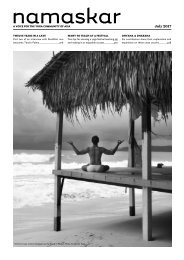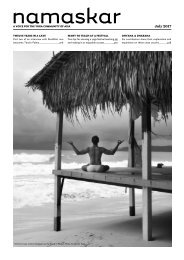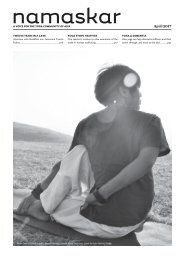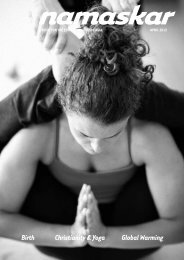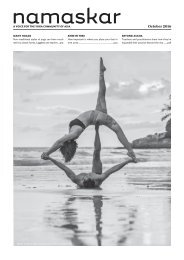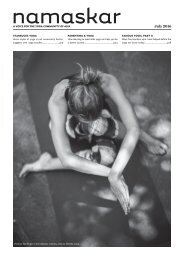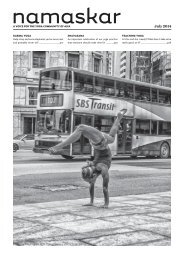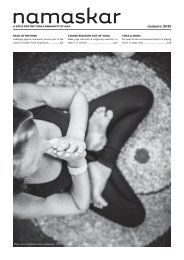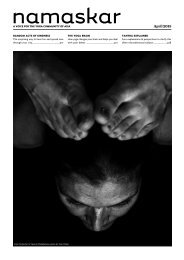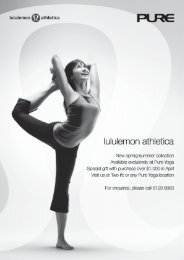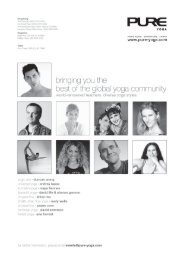Namaskar July 2010
Create successful ePaper yourself
Turn your PDF publications into a flip-book with our unique Google optimized e-Paper software.
Yoga Travels<br />
Tok<br />
okyo o Yoga -<br />
Tradition &<br />
Modern<br />
Inna Costantini<br />
WHAT IS IT LIKE TO PRACTICE IN<br />
one of the most modern, expensive and<br />
cutting-edge city in the world? Tokyo has<br />
for years been a trend-setting, buzzing<br />
capital, a hub for business, technology and<br />
consumer culture, attracting foreigners,<br />
tourists and the masses to its belly like a<br />
vortex running on adrenaline. Coffee can<br />
vending machines appear on virtually every<br />
street corner, station platform and parking<br />
lot, providing a quick fix solution to a<br />
demanding and hectic lifestyle.<br />
Shibuya, Ginza and Ueno – epic, buzzing<br />
districts, always seem to appear in visitors’<br />
snapshots of Japan, in the same way as<br />
London is famed for Piccadilly Circus and<br />
Big Ben. Media reports only reinforce this<br />
post-modern, stereotyped view of<br />
Japanese culture, so when I told friends I<br />
was off to investigate the yoga scene in<br />
Tokyo, I was greeted with some quizzical<br />
looks. Japan is certainly famous for its<br />
aesthetics, zen temples and spiritual roots,<br />
but yoga is a far more recent import.<br />
Although as a practice, yoga has been<br />
around for many years, the big boom<br />
started in 2004, when yoga became trendy<br />
in most parts of East Asia – following a<br />
global trend partly set by people like<br />
Madonna or Sting. But that boom only<br />
lasted for a couple of years in Japan – by<br />
2006, the few large yoga centers like Bikram<br />
Yoga had to close or downsize to adjust to<br />
falling numbers. The smaller, independent<br />
studios remained active and even grew with<br />
a smaller but more dedicated student base,<br />
some of whom having traveled or studied<br />
abroad, wanting to take their practice to<br />
another level. The current student base still<br />
remains fairly young, with a typical class<br />
consisting of a majority of 25-35 year old<br />
women, but there has recently been an<br />
increase in Japanese men joining classes.<br />
The fact that Yoga Journal just launched a<br />
quarterly edition in Japanese, should<br />
indicate that interest for yoga is here to stay,<br />
28<br />
Jogajaya teacher and owner Patrick Oancia (center)<br />
with a shift towards integrating yoga<br />
lifestyle into a modern environment.<br />
Different from many Asian cities, all the<br />
studios I visited in Tokyo were small (one<br />
room, holding up to 20 people on<br />
average), due to high rents and lack of<br />
space, but not surprisingly, all were<br />
extremely clean – students diligently<br />
spraying their mats after class wiping off<br />
every speck of dust or drop of sweat,<br />
tidying props and bolsters, in a typically<br />
respectful and dutiful manner.<br />
MINDFULNESS IN JAPAN’S CAPITAL<br />
My quest for places to practice yoga in<br />
Tokyo started in the West side of the city,<br />
in Ebisu, a quiet yet trendy and up-market<br />
area. It is also home to YogaJaya, one of<br />
Tokyo’s leading independent studios.<br />
Opened by Patrick Oancia in 2004, and<br />
neatly tucked away in a residential back<br />
street, YogaJaya is a peaceful abode to all<br />
things yoga. A small reception on the<br />
ground floor acts the shop, information<br />
desk and meeting point.<br />
I was greeted with a smile as I registered for<br />
Patrick’s busy Friday evening dynamic class.<br />
We all started by quietly sitting, while<br />
Patrick slipped in and led an extended<br />
breathing sequence. Core strength and arm<br />
balances happened to be the theme of the<br />
day, so we went straight into a playful,<br />
sweaty and hard session, but Patrick gave<br />
each student help and attention as if in a<br />
workshop.<br />
Browsing the schedule after class, I felt<br />
reassured to see handstand practice wasn’t a<br />
Japanese studio specialty, but rather a oneoff<br />
special: YogaJaya offers much more<br />
variety. Patrick pointed out that although<br />
dynamic styles are very popular, classes and<br />
workshops do range from gentler styles to<br />
meditation and pranayama with renowned<br />
practioners.<br />
But, as I asked Patrick after the class, is the<br />
yoga approach here, typically Japanese?<br />
How are students’ general attitude to life<br />
reflected in their practice? (Tricky question<br />
to answer when the class is a mix of men,<br />
women, foreigners and teacher training<br />
students).<br />
Japanese culture, he tells me, is on a very<br />
broad level, clearly regimented, structured<br />
and competitive. This is why at the start,<br />
dynamic practices like Astanga really kicked<br />
off. As a discipline, Astanga is systematic,<br />
organized and structured, which fits well<br />
with an ordered and controlled Japanese<br />
way of life. Students are generally dedicated<br />
and disciplined –often to the extreme,<br />
which is why they love this system.<br />
But aspects of a culture that can sometimes<br />
be extremely dogmatic never came across in<br />
my tour of Tokyo – and I saw fewer yoga<br />
fanatics than in London.<br />
Yoga Jaya has always shifted more towards<br />
other forms of yoga – they offer less<br />
Astanga classes to balance the schedule with<br />
other styles like Hatha Vinyasa, Yoga Focus



